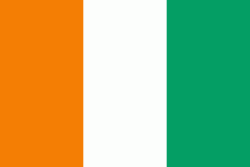Guiglo
Guiglo is a city in western Ivory Coast. It is a sub-prefecture of and the seat of Guiglo Department. It is also a commune and the seat of Cavally Region in Montagnes District. Guiglo is located on the Nzo River, a tributary of the Sassandra River. In the 2014 census, the city had a population of 52,544.
Guiglo is a market centre of the Guere, Yacouba and Mossi people, with trade in rice, livestock, and cassava predominating. The city is also a collecting depot, or entrepot, for coffee and timber that is taken to coastal ports for export. Guiglo is the site of both a research station and a sawmill.
In 2005, a United Nations base was invaded by 1,000 protesters. The protestors took control but were forced back by armed UN peacekeepers. The clash left 100 protesters and one UN peacekeeper dead.
The city is served by Guiglo Airport.
In 2021, the population of the sub-prefecture of Guiglo was 171,454.
The 18 villages of the sub-prefecture of Guiglo and their population in 2014 are: • # Domobly (5 128)
• # Glopaoudy (2 157)
• # Goya 1 (5 129)
• # Goya 2 (2 386)
• # Guiglo (52 544)
Guiglo is a market centre of the Guere, Yacouba and Mossi people, with trade in rice, livestock, and cassava predominating. The city is also a collecting depot, or entrepot, for coffee and timber that is taken to coastal ports for export. Guiglo is the site of both a research station and a sawmill.
In 2005, a United Nations base was invaded by 1,000 protesters. The protestors took control but were forced back by armed UN peacekeepers. The clash left 100 protesters and one UN peacekeeper dead.
The city is served by Guiglo Airport.
In 2021, the population of the sub-prefecture of Guiglo was 171,454.
The 18 villages of the sub-prefecture of Guiglo and their population in 2014 are: • # Domobly (5 128)
• # Glopaoudy (2 157)
• # Goya 1 (5 129)
• # Goya 2 (2 386)
• # Guiglo (52 544)
Map - Guiglo
Map
Country - Côte_d'Ivoire
 |
 |
| Flag of Ivory Coast | |
Before its colonization by Europeans, Ivory Coast was home to several states, including Gyaaman, the Kong Empire, and Baoulé. The area became a protectorate of France in 1843 and was consolidated as a French colony in 1893 amid the European Scramble for Africa. It achieved independence in 1960, led by Félix Houphouët-Boigny, who ruled the country until 1993. Relatively stable by regional standards, Ivory Coast established close political-economic ties with its West African neighbours while maintaining close relations with the West, especially France. Its stability was diminished by a coup d'état in 1999, then two civil wars—first between 2002 and 2007 and again during 2010–2011. It adopted a new constitution in 2016.
Currency / Language
| ISO | Currency | Symbol | Significant figures |
|---|---|---|---|
| XOF | West African CFA franc | Fr | 0 |
| ISO | Language |
|---|---|
| FR | French language |















